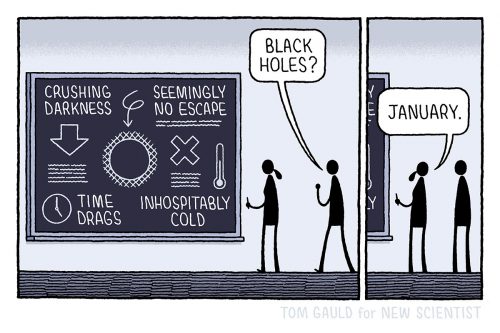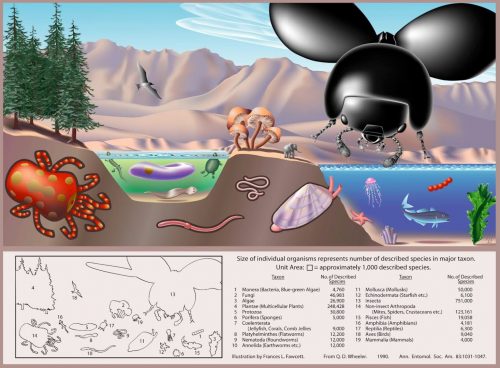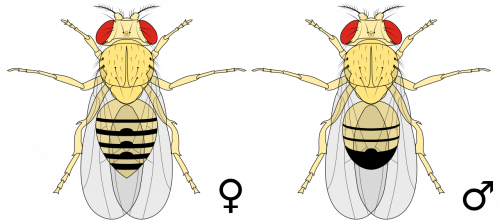I mentioned sex combs a while back, so I thought I’d clarify a bit — I hope none of you rushed out to buy one for yourself (I don’t think human sex combs exist, but if they do, I don’t need to know.) Sex combs are secondary sexual characteristics found in on the forelegs of only male Drosophilidae. They are small dark patches of bristles on the tarsus of the first leg, and they are not something you’d notice if you saw a fly buzzing in your kitchen — you have to knock them out and carefully scrutinize the limbs with a hand lens or microscope to see them, but they’re important for recognizing the sex of a fly definitively. I tell my genetics students that you can tell the sexes apart by the shape of the abdomen or the pigment patterns, but to be really sure you should check for the presence or absence of the sex combs.

Sex comb in Drosophila melanogaster male: a) front leg with sex comb marked with black arrow; b) sex comb bristles
They don’t look like much, but they also matter to female flies. Mutants or surgically modified male flies with the sex combs reduced suffer with lower reproductive success. The flies use them as gentle grasping tools to separate her wings, grasp her abdomen, and tease open the genitals, so of course they’re subject to selection. Different species of fruit flies exhibit different patterns of sex combs, and we observe natural variation within a species.

Sex comb (SC) diversity. A phylogeny of eight comb-bearing species, assuming that the montium subgroup is a sister-taxon to the
Oriental lineage, as in Kopp (2006). Branch lengths are not to scale. Note the variation in the length, size and orientation of the SCs.
Variation within and between species makes sex combs of great interest to evolutionary biologists. Here’s an illustration of the variation we can see.

Variation in sex comb tooth number and development. (A–C) Exam-
ples of Drosophilidae forelegs with long combs. (D and E) D. melanogaster
forelegs. (F–J) Schematics of foreleg development of the top Drosophila legs.
(K–O) Examples of D. melanogaster perturbations in sex comb tooth number.
(A–C and F–H) Drosophila species with long sex combs achieve vertical orien-
tation by different mechanisms: (i) Teeth initially form in a vertical orientation
(F) (e.g., D. ficusphila t1–t2); (ii) rotation of a long row (G) (e.g., D. guanche t1–t2
and D. rhopaloa t1); (iii) rotation of multiple small rows and posterior fusion
into a long sex comb (H) (e.g., D. rhopaloa t2). (D, E, I, and J) In D. melanogaster, the male sex comb rotates from a horizontal to a vertical position
(diagrammed in D), while TRs remain horizontal. The only exception is the
most distal transverse row (red dotted box in D and I), which bends proximally
close to the top part of the sex comb. In contrast, the female rows of bristles
homologous to the sex comb remain static during development (brackets in E
and J). In order to study the phenotypic and developmental effect of changing
the number of sex comb teeth, this trait was perturbed using artificial selection
(K and L), mutants (M–O), and UAS-Scr RNAi transgenic lines . Gray circles represent sex comb teeth in the initial position and
black circles represent sex comb teeth in the final position. Empty circles represent the TR bristles. Gray arrows indicate movement of individual tooth or
sex comb rows. Red brackets indicate sex combs or homologous female bristles. Red numbers represent the range of sex comb teeth in each line. babPR72, bric à bracPR72; scd, sex combs distal; Scr, sex combs reduced; t1 and t2, first and
second tarsal segment, respectively. Distal is down and posterior is to the right.
Scale bar: 20 μm.
Focus for now on the top panel on the right, which shows a male and a female foreleg. They both have hairy legs, and in the default pattern seen in the females is a series of bristles in transverse rows (TRs) in arrays marching down the leg. The flies specifically use these bristles to groom their eyes — if you look closely, flies are remarkably tidy and neat.
The TRs are illustrated diagrammatically as small open circles in rows, the base pattern. These bristles are also developmentally interesting, because the way you make a sex comb is you express a set of specific genes in the distal two rows, and the whole structure rotates 90° to form a longitudinal comb. This opens up a whole set of informative interactions — the rotation is essential for function, and is subject to constraints imposed by adjacent tissues. I’ve been reading papers for the past week focused on the developmental and evolutionary significance of this tiny, odd, little known structure in flies. You should read some of these papers, too! I’m a sucker for anything evo-devo, and that’s what this little patch of hairs illustrates.
The most complex and diverse secondary sexual character in Drosophila is the sex comb (SC), an arrangement of modified bristles on the forelegs of a subclade of male fruit flies. We examined SC formation in six representative nonmodel fruit fly species, in an effort to understand how the variation in comb patterning arises. We first compared SC development in two species with relatively small combs, Drosophila takahashii, where the SCs remain approximately transverse, and Drosophila biarmipes, where two rows of SC teeth rotate and move in an anterior direction relative to other bristle landmarks. We then analyzed comb ontogeny in species with prominent extended SCs parallel to the proximodistal axis, including Drosophila ficusphila and species of the montium subgroup. Our study allowed us to identify two general methods of generating longitudinal combs on the tarsus, and we showed that a montium subgroup species (Drosophila nikananu) with a comb convergently similar in size, orientation and position to the model organism Drosophila melanogaster, forms its SC through a different developmental mechanism. We also found that the protein product of the leg patterning gene, dachshund (dac), is strongly reduced in the SC in all species, but not in other bristles. Our results suggest that an apparent constraint on SC position in the adult may be attributable to at least two different lineage-specific developmental processes, although external forces could also play a role.
Atallah J, Liu NH, Dennis P, Hon A, and Larsen EW (2009) Developmental constraints and convergent evolution in Drosophila sex comb formation. Evolution & Development 11(2): 205-218.
Malagón JN, Ahujab A, Sivapatham G, Hung J, Leea J, Muñoz-Gómez SA, Atallah J, Singh RS, and Larsena E (2013) Evolution of Drosophila sex comb length illustrates the inextricable interplay between selection and variation www.pnas.org/cgi/doi/10.1073/pnas.1322342111










